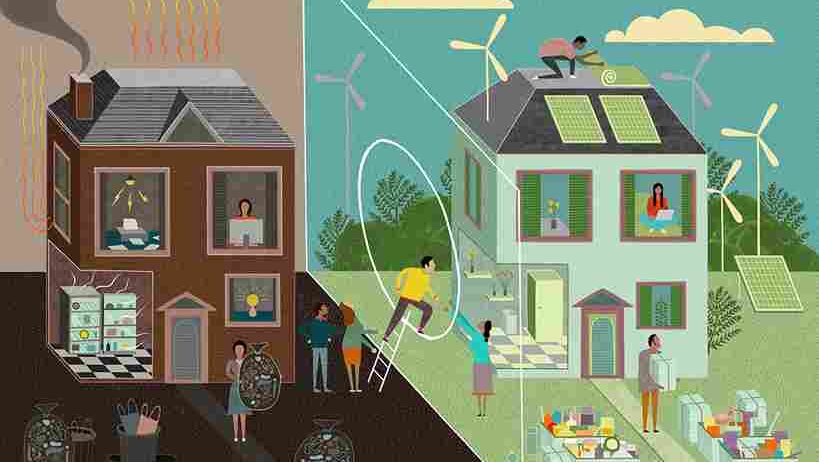In an era increasingly defined by climate awareness, the debate surrounding large homes and their contribution to global warming has gained traction. Commonly observed in suburban sprawl is the phenomenon of expansive residences, often seen as symbols of prosperity and personal comfort. However, beneath this facade of luxury lies a critical examination of the environmental ramifications associated with these sprawling properties.
Large homes, while providing ample living space, inherently require more resources—resources that significantly amplify their environmental impact. To grasp the depth of this issue, one must consider the carbon footprint associated with various aspects of massive dwellings, including energy consumption, construction materials, and maintenance needs.
Energy consumption is one of the most glaring elements contributing to the carbon footprint of large homes. The energy required to heat, cool, and power expansive living spaces is considerably greater than that needed for smaller homes. According to various studies, the energy consumption of a home often scales disproportionately with its size. While larger homes may boast multiple rooms and amenities, this increased space necessitates heightened energy expenditure. Heating a grand foyer or cooling a vast living area consumes significantly more energy, often leading to increased greenhouse gas emissions that exacerbate global warming.
Furthermore, the reliance on fossil fuels for heating and electricity exacerbates the problem. Many large homes are equipped with sophisticated heating and cooling systems that rely heavily on natural gas, oil, or coal. The combustion of these fossil fuels releases substantial quantities of carbon dioxide (CO2), a primary greenhouse gas contributing to climate change. The infrastructure supporting such large residences tends to be less efficient than that of smaller homes, leading to energy wastage and unresolved environmental concerns.
Construction materials also play a pivotal role in defining the carbon footprint of large homes. The manufacturing of building materials such as concrete, steel, and wood involves significant energy use and emissions. Large homes require vast quantities of these materials, leading to higher overall extraction, transportation, and processing emissions. For example, concrete production alone accounts for approximately 8% of global CO2 emissions. Moreover, the extraction of resources, particularly from forests, leads to habitat destruction and biodiversity loss, compounding the environmental crisis.
Additionally, the maintenance of extensive properties often necessitates considerable energy and water usage. Large homes typically require frequent landscaping, pool maintenance, and pest control—all of which consume additional resources. Landscaping alone has a considerable carbon footprint, particularly if it involves the use of gas-powered equipment, synthetic fertilizers, and excessive irrigation. Such practices not only contribute to CO2 emissions but also deplete local water sources, thereby exacerbating water scarcity issues.
In a broader societal context, the fascination with large homes can be attributed to cultural perceptions of success and achievement. This allure often overshadows the environmental consequences inherent in such lifestyles. Humans are drawn to the idea of having more—more space, more luxury, more status. However, this desire for excess conflicts with the overarching goal of reducing our ecological footprint. The dichotomy between personal comfort and environmental responsibility presents a complex challenge, as individuals grapple with balancing their desires against the pressing need for sustainability.
The concept of “right-sizing”—the trend toward more modest living spaces—has started to gain momentum in response to these challenges. As awareness grows regarding the interconnectedness of lifestyle choices and climate change, many individuals are opting for smaller, more energy-efficient homes that utilize sustainable materials and technologies. This shift not only reduces individual carbon footprints but also promotes a more efficient use of resources. In fact, research indicates that smaller homes tend to foster a sense of community and connection among inhabitants, further reinforcing the value of sustainable living.
Policy measures also play a crucial role in addressing the carbon footprint of large homes. Governments and local municipalities have begun to implement stricter building codes, energy efficiency standards, and incentives for sustainable living practices. These policies encourage developers to consider the environmental impacts of their projects while urging homeowners to invest in energy-efficient upgrades. Transitioning to renewable energy sources, such as solar panels, can significantly mitigate the effects of large homes on global warming, providing a crucial counterbalance to their inherent resource demands.
Ultimately, the relationship between large homes and global warming encapsulates a broader societal dilemma: how to reconcile personal desires with collective responsibility. While luxury and comfort undoubtedly hold appeal, it is imperative to critically evaluate the environmental consequences of our choices. By embracing more sustainable lifestyles, including downsizing and promoting energy-efficient practices, society can collectively work towards curbing the detrimental effects of climate change.
The challenge lies in transforming our fascination with grandeur into a commitment to sustainability. As global temperatures continue to rise and climate-related disasters become increasingly common, it is clear that the time for action is now. Our homes, whether large or small, should reflect our values—not only as individuals seeking comfort but as stewards of the planet. By acknowledging the carbon footprint of comfort and addressing the need for change, we can forge a path toward a more sustainable and responsible future.








